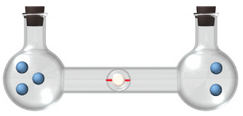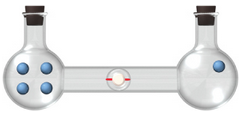
Chemistry: Structure and Properties (2nd Edition)
2nd Edition
ISBN: 9780134293936
Author: Nivaldo J. Tro
Publisher: PEARSON
expand_more
expand_more
format_list_bulleted
Textbook Question
Chapter 18, Problem 104E
Calculate the entropy of each state and rank the states in order of increasing entropy.
Expert Solution & Answer
Want to see the full answer?
Check out a sample textbook solution
Students have asked these similar questions
Viscosity of a liquid related to the activation energy.
Vibrational contributions to internal energy and heat capacity1) are temperature independent2) are temperature dependent
The approximation of calculating the partition function by integration instead of the summation of all the energy terms can only be done if the separation of the energy levels is much smaller than the product kT. Explain why.
Chapter 18 Solutions
Chemistry: Structure and Properties (2nd Edition)
Ch. 18 - What is the first law of thermodynamics, and how...Ch. 18 - What is nature’s heat tax, and how does it relate...Ch. 18 - What is a perpetual motion machine? Can such a...Ch. 18 - Is it more efficient to heat your home with a...Ch. 18 - What is a spontaneous process? Provide an example.Ch. 18 - Explain the difference between the spontaneity of...Ch. 18 - What is the precise definition of entropy? What is...Ch. 18 - Why does the entropy of a gas increase when it...Ch. 18 - Explain the difference between macrostates and...Ch. 18 - Based on its fundamental definition, explain why...
Ch. 18 - State the second law of thermodynamics. How does...Ch. 18 - What happens to the entropy of a sample of matter...Ch. 18 - Explain why water spontaneously freezes to form...Ch. 18 - Why do exothermic processes tend to be spontaneous...Ch. 18 - What is the significance of the change in Gibbs...Ch. 18 - Predict the spontaneity of a reaction (and the...Ch. 18 - State the third law of thermodynamics and explain...Ch. 18 - Why is the standard entropy of a substance in the...Ch. 18 - How does the standard entropy of a substance...Ch. 18 - How can you calculate the standard entropy change...Ch. 18 - Describe the three different methods to calculate...Ch. 18 - Why is free energy “free”?Ch. 18 - Explain the difference between G and G .Ch. 18 - Why does water spilled on the floor evaporate even...Ch. 18 - How do you calculate the change ¡n free energy for...Ch. 18 - How does the value of G for a reaction relate to...Ch. 18 - Prob. 27ECh. 18 - Prob. 28ECh. 18 - Prob. 29ECh. 18 - Prob. 30ECh. 18 - Calculate the change in entropy that occurs in the...Ch. 18 - Prob. 32ECh. 18 - Calculate the change ¡n entropy that occurs in the...Ch. 18 - Prob. 34ECh. 18 - Without doing any calculations, determine the sign...Ch. 18 - Prob. 36ECh. 18 - Without doing any calculations, determine the sign...Ch. 18 - Prob. 38ECh. 18 - Calculate Ssurr at the indicated temperature for...Ch. 18 - Prob. 40ECh. 18 - Given the values of Hrxn , Srxn and T, determine...Ch. 18 - Prob. 42ECh. 18 - Prob. 43ECh. 18 - Prob. 44ECh. 18 - Calculate the free energy change for the reaction...Ch. 18 - Prob. 46ECh. 18 - Prob. 47ECh. 18 - Predict the conditions (high temperature, low...Ch. 18 - How does the molar entropy of a substance change...Ch. 18 - What is the molar entropy of a pure crystal at 0...Ch. 18 - For each pair of substances, choose the one that...Ch. 18 - For each pair of substances, choose the one that...Ch. 18 - Rank each set of substances in order of increasing...Ch. 18 - Prob. 54ECh. 18 - Use data from Appendix IIB to calculate Srxn for...Ch. 18 - Use data from Appendix IIB to calculate Srxn for...Ch. 18 - Find S for the formation of CH2Cl2(g) from its...Ch. 18 - Prob. 58ECh. 18 - Methanol burns in oxygen to form carbon dioxide...Ch. 18 - In photosynthesis, plants form glucose (C6H12O6)...Ch. 18 - For each reaction, calculate Hrxn , Srxn and Grxn...Ch. 18 - For each reaction calculate Hrxn , Srxn and Grxn...Ch. 18 - Use standard free energies of formation to...Ch. 18 - Use standard free energies of formation to...Ch. 18 - Consider the reaction: 2NO(g)+O2(g)2NO2(g)...Ch. 18 - Prob. 66ECh. 18 - Determine G for the reaction:...Ch. 18 - Prob. 68ECh. 18 - Consider the sublimation of iodine at 25.0°C:...Ch. 18 - Consider the evaporation of methanol at 25.0°C....Ch. 18 - Consider the reaction: CH3OH(g)CO(g)+2H2(g)...Ch. 18 - Consider the reaction: CO2(g)+CCl4(g)2COCl2(g)...Ch. 18 - Use data from Appendix IIB to calculate the...Ch. 18 - Prob. 74ECh. 18 - Prob. 75ECh. 18 - Prob. 76ECh. 18 - Prob. 77ECh. 18 - Prob. 78ECh. 18 - Consider the reaction: H2(g)+I2(g)2HI(g) The...Ch. 18 - Consider the reaction: 2N0(g) — O(g) 2N02(g) The...Ch. 18 - The change in enthalpy (Hrxn) for a reaction is...Ch. 18 - Prob. 82ECh. 18 - Prob. 83ECh. 18 - Prob. 84ECh. 18 - Our atmosphere is composed primarily of nitrogen...Ch. 18 - Prob. 86ECh. 18 - Ethene (C2H4) can be halogenated by the reaction:...Ch. 18 - H2 reacts with the halogens (X2) according to the...Ch. 18 - Consider this reaction occurring at 298 K:...Ch. 18 - Consider this reaction occurring at 298 K:...Ch. 18 - Prob. 91ECh. 18 - Prob. 92ECh. 18 - These reactions are important in catalytic...Ch. 18 - Prob. 94ECh. 18 - All the oxides of nitrogen have positive values of...Ch. 18 - Prob. 96ECh. 18 - Consider the reaction X2(g)2X(g) . When a vessel...Ch. 18 - Prob. 98ECh. 18 - Indicate and explain the sign of Suniv for each...Ch. 18 - The Haber process is very important for...Ch. 18 - A metal salt with the formula MCl2 crystallizes...Ch. 18 - The solubility of AgCI(s) in water at 25°C is...Ch. 18 - Review the subsection in this chapter entitled...Ch. 18 - Calculate the entropy of each state and rank the...Ch. 18 - Suppose we redefine the standard state as P=2atm ....Ch. 18 - The G for the freezing of H2O(l) at 10°C is 210...Ch. 18 - Consider the reaction that occurs during the Haber...Ch. 18 - The salt ammonium nitrate can follow three modes...Ch. 18 - Given the tabulated data, calculate Svap for each...Ch. 18 - Prob. 110ECh. 18 - Prob. 111ECh. 18 - Consider the changes in the distribution of nine...Ch. 18 - Prob. 113ECh. 18 - Prob. 114ECh. 18 - Prob. 115ECh. 18 - The reaction A(g)B(g) has an equilibrium constant...Ch. 18 - Prob. 117ECh. 18 - Prob. 118ECh. 18 - Prob. 119ECh. 18 - Have each group member look up Hf and S for one...Ch. 18 - Calculate G at 25°C for the reaction in the...Ch. 18 - Prob. 122ECh. 18 - Which reaction Is most likely to have a positive...Ch. 18 - Prob. 2SAQCh. 18 - Arrange the gases—F2, Ar, and CH3F—in order of...Ch. 18 - Prob. 4SAQCh. 18 - Prob. 5SAQCh. 18 - For a certain reaction Hrxn=255kJ and Srxn=211J/K...Ch. 18 - Prob. 7SAQCh. 18 - s8. Use standard free energies of formation to...Ch. 18 - Prob. 9SAQCh. 18 - For the following reaction, Grxn=9.4kJ at 25 °C....Ch. 18 - Prob. 11SAQCh. 18 - Prob. 12SAQCh. 18 - Prob. 13SAQCh. 18 - Prob. 14SAQCh. 18 - Prob. 15SAQCh. 18 - Prob. 16SAQ
Additional Science Textbook Solutions
Find more solutions based on key concepts
An aluminum calorimeter with a mass of 100 g contains 250 g of water. The calorimeter and water are in thermal ...
Physics for Scientists and Engineers
1. Rub your hands together vigorously. What happens? Discuss the energy transfers and transformations that take...
College Physics: A Strategic Approach (3rd Edition)
How could you separate a mixture of the following compounds? The reagents available to you are water, either, 1...
Organic Chemistry (8th Edition)
Single penny tossed 20 times and counting heads and tails: Probability (prediction): _______/20 heads ________/...
Laboratory Manual For Human Anatomy & Physiology
Label each statement about the polynucleotide ATGGCG as true or false. The polynucleotide has six nucleotides. ...
General, Organic, and Biological Chemistry - 4th edition
Knowledge Booster
Learn more about
Need a deep-dive on the concept behind this application? Look no further. Learn more about this topic, chemistry and related others by exploring similar questions and additional content below.Similar questions
- Explain the meaning of: the electron partition function is equal to the degeneracy of the ground state.arrow_forward28. For each of the following species, add charges wherever required to give a complete, correct Lewis structure. All bonds and nonbonded valence electrons are shown. a. b. H H H H H :0-C-H H H H-C-H C. H H d. H-N-0: e. H H-O H-O H B=0 f. H—Ö—Ñ—Ö—H Norton Private Barrow_forwardAt 0oC and 1 atm, the viscosity of hydrogen (gas) is 8.55x10-5 P. Calculate the viscosity of a gas, if possible, consisting of deuterium. Assume that the molecular sizes are equal.arrow_forward
- Indicate the correct option for the velocity distribution function of gas molecules:a) its velocity cannot be measured in any other way due to the small size of the gas moleculesb) it is only used to describe the velocity of particles if their density is very high.c) it describes the probability that a gas particle has a velocity in a given interval of velocitiesd) it describes other magnitudes, such as pressure, energy, etc., but not the velocity of the moleculesarrow_forwardIndicate the correct option for the velocity distribution function of gas molecules:a) its velocity cannot be measured in any other way due to the small size of the gas moleculesb) it is only used to describe the velocity of particles if their density is very high.c) it describes the probability that a gas particle has a velocity in a given interval of velocitiesd) it describes other magnitudes, such as pressure, energy, etc., but not the velocity of the moleculesarrow_forwardDraw the skeletal structure of the alkane 4-ethyl-2, 2, 5, 5- tetramethylnonane. How many primary, secondary, tertiary, and quantenary carbons does it have?arrow_forward
- Electronic contribution to the heat capacity at constant volume A) is always zero B) is zero, except for excited levels whose energy is comparable to KT C) equals 3/2 Nk D) equals Nk exp(BE)arrow_forwardPlease correct answer and don't used hand raitingarrow_forwardCalculate the packing factor of CaTiO3. It has a perovskite structure. Data: ionic radii Co²+ = 0.106 nm, Ti4+ = 0.064 nm, O² = 0.132 nm; lattice constant is a = 2(rTi4+ + ro2-). Ca2+ 02- T14+ Consider the ions as rigid spheres. 1. 0.581 or 58.1% 2. -0.581 or -58.1 % 3. 0.254 or 25.4%arrow_forward
arrow_back_ios
SEE MORE QUESTIONS
arrow_forward_ios
Recommended textbooks for you
- Chemistry: Matter and ChangeChemistryISBN:9780078746376Author:Dinah Zike, Laurel Dingrando, Nicholas Hainen, Cheryl WistromPublisher:Glencoe/McGraw-Hill School Pub Co
 Chemistry: The Molecular ScienceChemistryISBN:9781285199047Author:John W. Moore, Conrad L. StanitskiPublisher:Cengage Learning
Chemistry: The Molecular ScienceChemistryISBN:9781285199047Author:John W. Moore, Conrad L. StanitskiPublisher:Cengage Learning
 Introductory Chemistry: A FoundationChemistryISBN:9781337399425Author:Steven S. Zumdahl, Donald J. DeCostePublisher:Cengage Learning
Introductory Chemistry: A FoundationChemistryISBN:9781337399425Author:Steven S. Zumdahl, Donald J. DeCostePublisher:Cengage Learning Principles of Modern ChemistryChemistryISBN:9781305079113Author:David W. Oxtoby, H. Pat Gillis, Laurie J. ButlerPublisher:Cengage Learning
Principles of Modern ChemistryChemistryISBN:9781305079113Author:David W. Oxtoby, H. Pat Gillis, Laurie J. ButlerPublisher:Cengage Learning Chemistry & Chemical ReactivityChemistryISBN:9781133949640Author:John C. Kotz, Paul M. Treichel, John Townsend, David TreichelPublisher:Cengage Learning
Chemistry & Chemical ReactivityChemistryISBN:9781133949640Author:John C. Kotz, Paul M. Treichel, John Townsend, David TreichelPublisher:Cengage Learning

Chemistry: Matter and Change
Chemistry
ISBN:9780078746376
Author:Dinah Zike, Laurel Dingrando, Nicholas Hainen, Cheryl Wistrom
Publisher:Glencoe/McGraw-Hill School Pub Co

Chemistry: The Molecular Science
Chemistry
ISBN:9781285199047
Author:John W. Moore, Conrad L. Stanitski
Publisher:Cengage Learning


Introductory Chemistry: A Foundation
Chemistry
ISBN:9781337399425
Author:Steven S. Zumdahl, Donald J. DeCoste
Publisher:Cengage Learning

Principles of Modern Chemistry
Chemistry
ISBN:9781305079113
Author:David W. Oxtoby, H. Pat Gillis, Laurie J. Butler
Publisher:Cengage Learning

Chemistry & Chemical Reactivity
Chemistry
ISBN:9781133949640
Author:John C. Kotz, Paul M. Treichel, John Townsend, David Treichel
Publisher:Cengage Learning
The Laws of Thermodynamics, Entropy, and Gibbs Free Energy; Author: Professor Dave Explains;https://www.youtube.com/watch?v=8N1BxHgsoOw;License: Standard YouTube License, CC-BY


